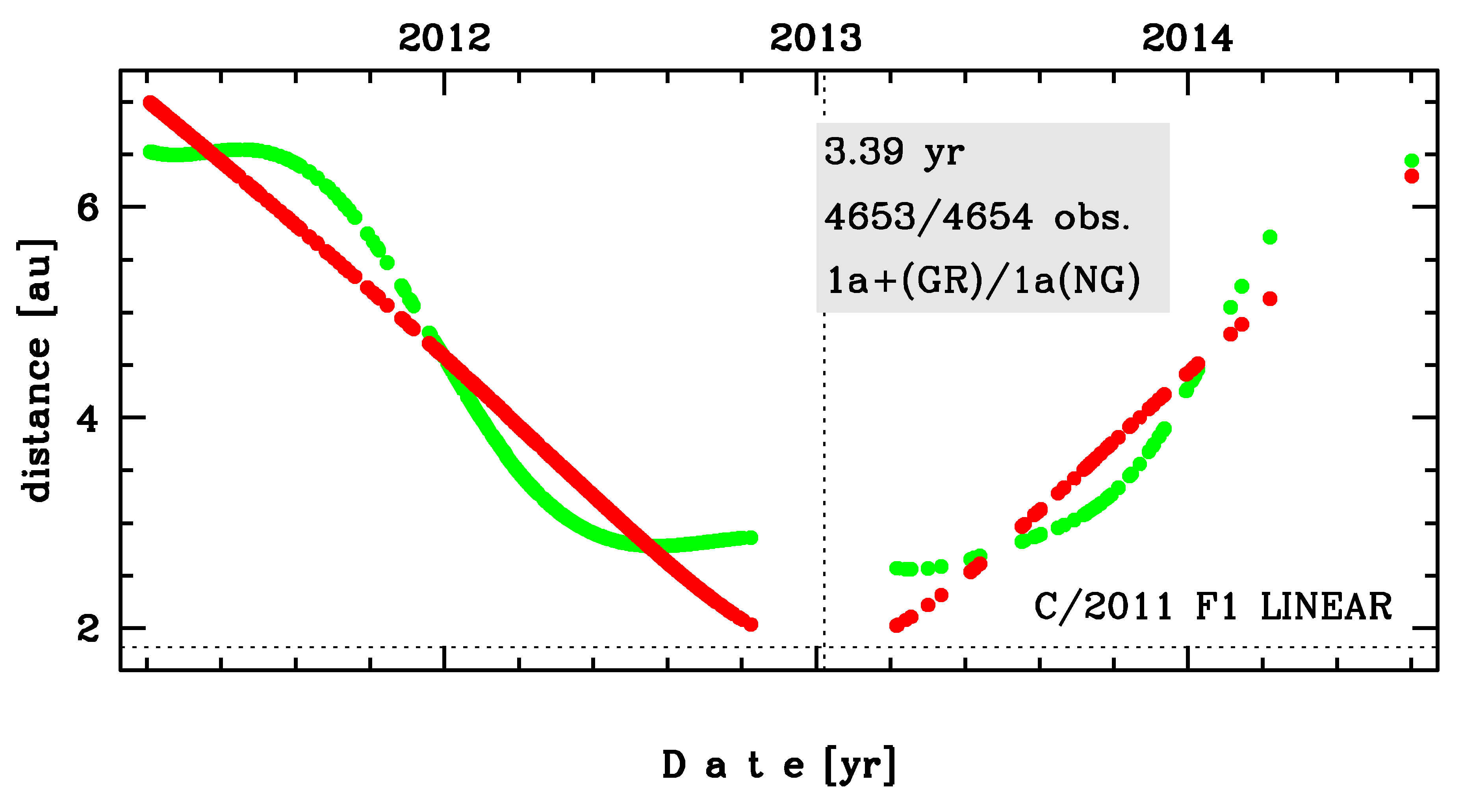C/2011 F1 LINEAR
more info
Comet C/2011 F1 was discovered on 17 March 2011 with Lincoln Laboratory Near-Earth Asteroid Research project; that is about a year and 10 months before its perihelion passage. The comet was observed until 7 August 2014.
Comet had its closest approach to the Earth on 6 April 2013 (2.560 au), about 3 months after its perihelion passage.
Solutions given here are based on data spanning over 3.39 yr in a range of heliocentric distances: 6.99 au – 1.819 au (perihelion) – 6.30 au.
This Oort spike comet suffers moderate planetary perturbations during its passage through the planetary system; these perturbations lead to a more tight future orbit (see future barycentric orbits).
See also Królikowska 2020.
Comet had its closest approach to the Earth on 6 April 2013 (2.560 au), about 3 months after its perihelion passage.
Solutions given here are based on data spanning over 3.39 yr in a range of heliocentric distances: 6.99 au – 1.819 au (perihelion) – 6.30 au.
This Oort spike comet suffers moderate planetary perturbations during its passage through the planetary system; these perturbations lead to a more tight future orbit (see future barycentric orbits).
See also Królikowska 2020.
| solution description | ||
|---|---|---|
| number of observations | 4653 | |
| data interval | 2011 03 17 – 2014 08 07 | |
| data type | perihelion within the observation arc (FULL) | |
| data arc selection | entire data set (STD) | |
| range of heliocentric distances | 6.99 au – 1.82 au (perihelion) – 6.3 au | |
| detectability of NG effects in the comet's motion | comet with determinable NG~orbit | |
| type of model of motion | GR - gravitational orbit | |
| data weighting | YES | |
| number of residuals | 9257 | |
| RMS [arcseconds] | 0.47 | |
| orbit quality class | 1a+ | |
| previous orbit statistics, both Galactic and stellar perturbations were taken into account | ||
|---|---|---|
| no. of returning VCs in the swarm | 5001 | * |
| no. of escaping VCs in the swarm | 0 | |
| no. of hyperbolas among escaping VCs in the swarm | 0 | |
| previous reciprocal semi-major axis [10-6 au-1] | 24.47 – 24.81 – 25.13 | |
| previous perihelion distance [au] | 853.6 – 862.7 – 871.3 | |
| previous aphelion distance [103 au] | 78.7 – 79.8 – 80.9 | |
| time interval to previous perihelion [Myr] | 7.77 – 7.94 – 8.11 | |
| percentage of VCs with qprev > 20 | 100 | |
| previous_g orbit statistics, here only the Galactic tide has been included | ||
|---|---|---|
| no. of returning VCs in the swarm | 5001 | * |
| no. of escaping VCs in the swarm | 0 | |
| no. of hyperbolas among escaping VCs in the swarm | 0 | |
| previous reciprocal semi-major axis [10-6 au-1] | 24.52 – 24.91 – 25.28 | |
| previous perihelion distance [au] | 18.1 – 19.5 – 21.1 | |
| previous aphelion distance [103 au] | 79.1 – 80.3 – 81.5 | |
| time interval to previous perihelion [Myr] | 7.94 – 8.13 – 8.32 | |
| percentage of VCs with 10 < qprev < 20 | 64 | |
| percentage of VCs with qprev > 20 | 36 | |
